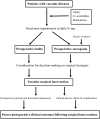Current Clinical Implications of Frailty and Sarcopenia in Vascular Surgery: A Comprehensive Review of the Literature and Consideration of Perioperative Management
- PMID: 36310738
- PMCID: PMC9558142
- DOI: 10.3400/avd.ra.22-00035
Current Clinical Implications of Frailty and Sarcopenia in Vascular Surgery: A Comprehensive Review of the Literature and Consideration of Perioperative Management
Abstract
Frailty is a well-known geriatric syndrome of impaired physiological reserve and increased vulnerability to stressors. Sarcopenia is also used as a parameter of physical impairment characterized by muscle weakness. As population aging has become more prominent in recent years, both modalities are now regarded as clinically important prognostic tools defined by multidimensional factors that may affect clinical outcomes in various clinical settings. A preoperative surgical risk analysis is mandatory to predict clinical and surgical outcomes in all surgical practices, particularly in high-risk surgical patients. In vascular surgical settings, frailty and sarcopenia have been accepted as useful prognostic tools to evaluate patient characteristics before surgery, as these may predict perioperative clinical and surgical outcomes. Although minimally invasive surgical approaches, such as endovascular therapy, and hybrid approaches have been universally developed, achieving good vascular surgical outcomes for high-risk cohorts remains to be challenge due to the increasing prevalence of elderly patients and multiple preoperative co-morbidities in addition to frailty and sarcopenia. Therefore, to further improve clinical and surgical outcomes, these preoperative geriatric prognostic factors will be of great importance and interest in vascular surgical settings for both physicians and surgeons.
Keywords: aortic aneurysm; frailty; peripheral arterial disease; sarcopenia; vascular surgery.
© 2022 The Editorial Committee of Annals of Vascular Diseases.
Conflict of interest statement
Conflict of InterestAuthor has no conflict of interest to declare with regard to this review article.
Figures
References
-
- Rockwood K, Stadnyk K, MacKnight C, et al. A brief clinical instrument to classify frailty in elderly people. Lancet 1999; 353: 205-6. - PubMed
-
- Fried LP, Tangen CM, Walston J, et al. Frailty in older adults: evidence for a phenotype. J Gerontol A Biol Sci Med Sci 2001; 56: M146-56. - PubMed
-
- Oresanya LB, Lyons WL, Finlayson E. Preoperative assessment of the older patient: a narrative review. JAMA 2014; 311: 2110-20. - PubMed
LinkOut - more resources
Full Text Sources
Research Materials


